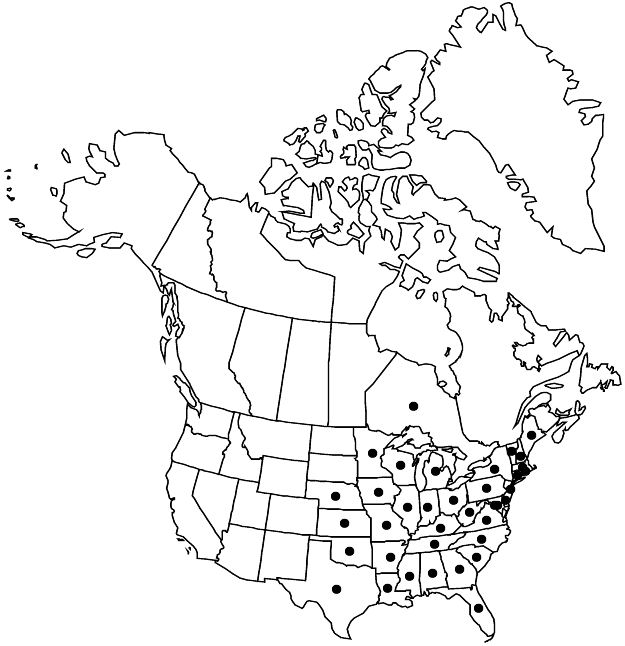Vitis aestivalis
Fl. Bor.-Amer. 2: 230. 1803.
Plants high climbing, sparsely branched. Branches: bark exfoliating in shreds; nodal diaphragms 1–4 mm thick; branchlets terete, tomentose, arachnoid-floccose, or glabrous, growing tips not enveloped by unfolding leaves; tendrils along length of branchlets, persistent, tendrils (or inflorescences) at only 2 consecutive nodes; nodes not red-banded. Leaves: stipules 1–4 mm; petiole ± equaling blade; blade cordate to orbiculate, 7–25 cm, unlobed to 3-shouldered or 3–5-lobed, sometimes deeply so, apex acute to short acuminate, abaxial surface glaucous, ± arachnoid or floccose, visible through hairs, hairs usually rusty, sometimes whitish, veins and vein-axils sometimes hirtellous, adaxial surface glabrous or puberulent. Inflorescences 7–20 cm. Flowers functionally unisexual. Berries black, glaucous, globose, 8–20 mm diam., skin separating from pulp; lenticels absent. 2n = 38.
Phenology: Flowering Apr–Jun; fruiting Jul–Sep.
Habitat: Woodlands, woodland borders, thickets, fence- and hedgerows, scrub, stabilized dunes, stream or riverbanks, floodplain and upland forests, lowland woods.
Elevation: 0–2000 m.
Distribution

Ont., Ala., Ark., Conn., Del., D.C., Fla., Ga., Ill., Ind., Iowa, Kans., Ky., La., Maine, Md., Mass., Mich., Minn., Miss., Mo., Nebr., N.H., N.J., N.Y., N.C., Ohio, Okla., Pa., R.I., S.C., Tenn., Tex., Vt., Va., W.Va., Wis.
Discussion
Vitis aestivalis is sometimes confused with V. cinerea. However, the glaucous abaxial leaf surfaces, more heavily glaucous and larger berries, terete branchlets that are less evenly pubescent, preference for better drained, drier habitats, and earlier blooming period distinguish V. aestivalis from V. cinerea.
Several varieties have been recognized based on leaf and young stem pubescence and fruit sizes (B. L. Comeaux et al. 1987; M. O. Moore 1991). The boundaries of the varieties are highly inconsistent and it is often difficult to apply the varietal concepts in the field. Recent molecular evidence supports the monophyly of V. aestivalis, but none of the varieties were supported as monophyletic (Wan Y. et al. 2013).
Selected References
None.
Lower Taxa
"connate" is not a number.